Karsten E. Hartel
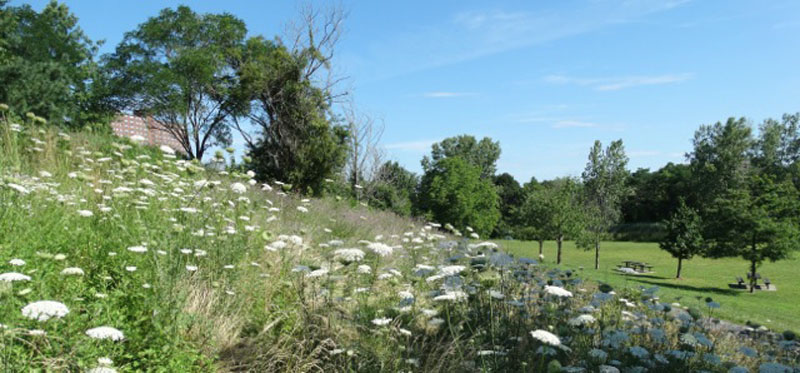
Grassy hillside opposite wetland. Photograph by Karsten E. Hartel.
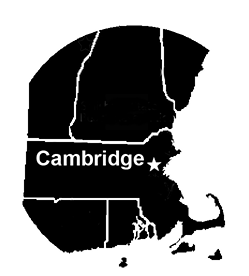 Thomas W. Danehy Park, named after a former mayor of Cambridge, sits atop an area that was an active dump until it was closed in the 1970s. The dump was capped and landscaped when the park was established in 1992, and then further renovated in 2001. The 49-acre area is a true urban recreation park situated behind and east of Fresh Pond Mall and Apple Cinema and bounded by New Street to the west, Sherman Street to the east, and Field and Garden streets to the south. To the north it is bounded by neighborhoods and active commuter rail tracks. St. Peter’s Field abuts the southeast section and contains a playing field. A large part of the western-central area of Danehy Park contains playing fields and a large oval running track. Most of the soccer fields are now surfaced with artificial turf. The park also has a fenced off-leash area for the use of dogs and their owners. However, dogs are often walked leashed and unleashed through all parts of the park. Walkers, people pushing baby-carriages, runners, and bicyclists should be expected on all the roads and paths, and patience is often required when you are trying to get on an interesting bird.
Thomas W. Danehy Park, named after a former mayor of Cambridge, sits atop an area that was an active dump until it was closed in the 1970s. The dump was capped and landscaped when the park was established in 1992, and then further renovated in 2001. The 49-acre area is a true urban recreation park situated behind and east of Fresh Pond Mall and Apple Cinema and bounded by New Street to the west, Sherman Street to the east, and Field and Garden streets to the south. To the north it is bounded by neighborhoods and active commuter rail tracks. St. Peter’s Field abuts the southeast section and contains a playing field. A large part of the western-central area of Danehy Park contains playing fields and a large oval running track. Most of the soccer fields are now surfaced with artificial turf. The park also has a fenced off-leash area for the use of dogs and their owners. However, dogs are often walked leashed and unleashed through all parts of the park. Walkers, people pushing baby-carriages, runners, and bicyclists should be expected on all the roads and paths, and patience is often required when you are trying to get on an interesting bird.
The northeast side of the park was designed as a natural area and runs for a quarter mile south and east from the New Street parking area to a tot lot near the Sherman Street parking lot and entrance. The southernmost 700 feet is a wetland area that usually holds water most of the year. For more information on the design, structure, and goals of this part of the park, see the City of Cambridge website, cited in references.
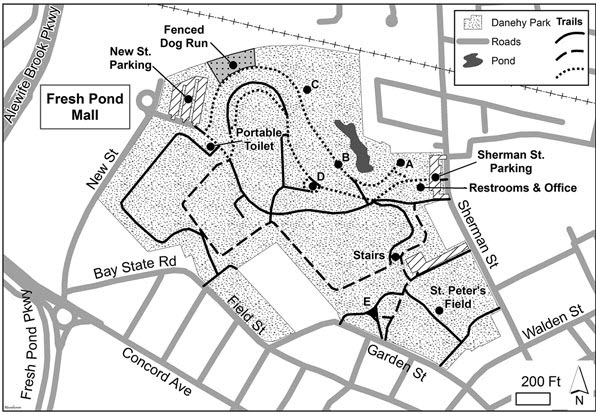
Birds at Danehy Park
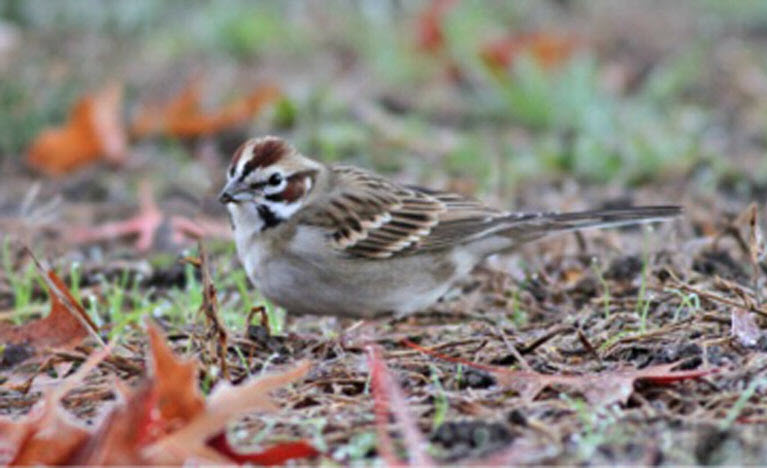
Lark Sparrow. Photograph by Jeremiah Trimble.
Records show 171 species of birds visiting the park between 2005 and the present (based on 973 eBird checklists). Bird records are primarily from September to December, the season when 70 percent of the checklists were submitted. There are very few breeding bird records, and only 45 checklists were submitted between June and August during the almost 20 years of eBird records. The greatest number of bird species is directly tied to dates before the unmowed grasses are cut, about early to mid-November, after which the numbers of bird species decline. This is especially true at “Sparrow Hill” and the other un-mowed areas, where 18 species of sparrows have been seen, including the locally rare Grasshopper, Le Conte’s, Nelson’s, and Vesper sparrows. Clay-colored, Lark, and Lincoln’s sparrows can almost be considered regular annual visitors. Dickcissel or Blue Grosbeak also might show up in the fall.
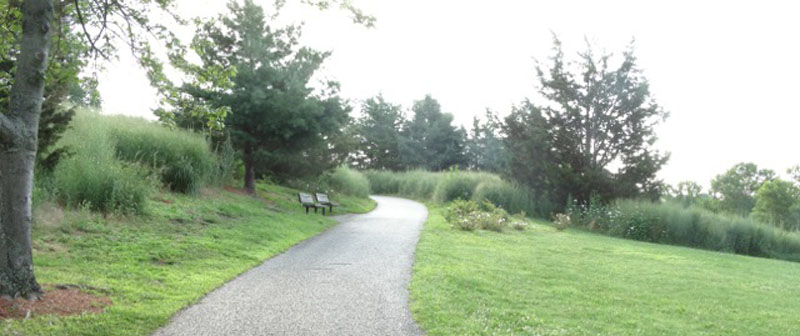
Path up Sparrow Hill. Photograph by Karsten E. Hartel.
Other bird groups, from hawks and falcons to a variety of warblers and vireos, also show up, but often not in large numbers. All three local falcons are annual at Danehy, and Peregrine Falcons are often year-round on the apartment towers to the north of the park. Twenty-nine species of wood-warblers have been recorded, including regular Orange-crowned Warblers along with Philadelphia Vireos that turn up in the fall.
Killdeer and Wilson’s Snipe can still be expected, but it is unlikely that the seven other plovers and sandpipers that historically dropped into the wet fields during inclement migration days will be seen there again since most of those soccer fields are now artificial turf.
Due to the open nature of the park, flyover species such as hawks, falcons, gulls, Common Nighthawks, Chimney Swifts, and Common Ravens can be seen passing over the park, often heading to and from Fresh Pond, which is less than ¼ mile away. If you are standing on the open slope of Sparrow Hill early on a fall morning and have good ears, you might hear numbers of wood-warblers flying over or dropping into the taller trees.
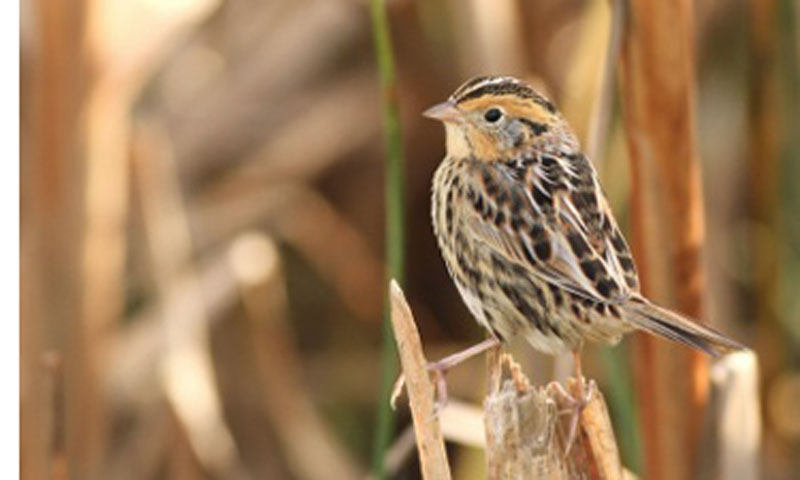
Le Conte’s Sparrow. Photograph by Jeremiah Trimble.
Danehy Park is a place where almost anything might drop in or fly over in the fall. Some of the more interesting records include Glossy Ibis, Gray Flycatcher, Ash-throated Flycatcher, Northern Shrike, Blue Grosbeak, Dickcissel, Eastern Meadowlark, and even some winter finches.
Finding Birds in Danehy Park
Walking paths (see map): The primary half-mile birding path (indicated with dots) runs from the Sherman Street parking entrance, along the wetland, around the oval track, and over the top of Sparrow Hill. This route covers most of the better birding areas. The top of Sparrow Hill is 50 feet above sea level and almost 40 feet above much of this part of Cambridge. The perimeter path (indicated with dashes) follows the outer edges of the southern portion of the park and is one mile long.
As noted below in the directions, there are two parking lots. When I lead my autumn morning walks (see posts on Arlington Birds and BBC trip lists), I ask people to park in the Sherman Street lot. This gives immediate access to the maintenance building and restrooms. Each of the major mentioned areas is labeled in capital letters (A-E) on the map.
From the maintenance building, go slightly left and past the tot lot to an overlook (A). This spot is good for a mix of birds, in part because the houses just outside the park here currently have feeders. Continue left along the wetland (B). You can walk on the grass or on the path. Walking on the path allows birding the tops of the tall willows. Continue along the path to an open area with a picnic table (C). Along the way, look over the mowed grass between the path, the wetland, and the taller trees beyond. Also look over the grass leading up to Sparrow Hill (D) and the hillside with small trees and grasses with a fence at the top. The path just beyond the fence on the hill is an optional part of a route from the other side looking down. If desired, walk along the seasonally flooded wooded wetland. You will pass a batting cage and a “hammer throw box” and come to a fence that bisects the area. There is a small wet area between the fence and the dog run that sometimes holds Wilson’s Snipe during spring migration.
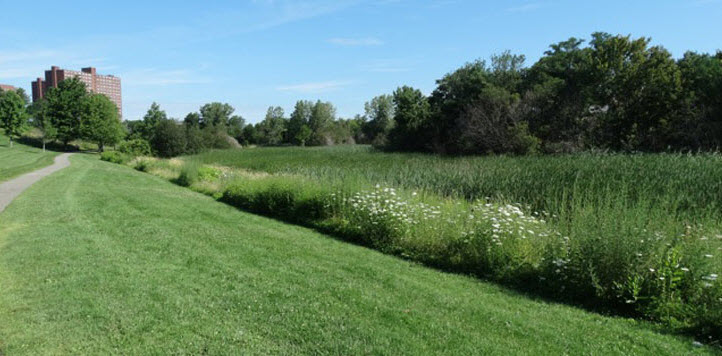
Wetland edge looking north. Photograph by Karsten E. Hartel.
Walk past the dog run and the New Street parking area to the wide main road that runs through the park (portable toilets are located here). From here, just uphill from the portable toilets, you may decide either to go left off the main road to a path parallel around the oval track and eventually up and over Sparrow Hill (D) or take the perimeter path by turning right at a small fenced tot lot. The left path attracts sparrows that feed on the path and along its edges. It is best to walk close to the track and not flush the birds. People will often come by and inadvertently flush them, but the birds usually come back to the path. At Sparrow Hill stop and wait at the sharp bend where you can look up and down the path as the birds return. At the top of the hill is a silver-colored bench where you can go down the grass hill and back to the maintenance building. Don’t forget to check the corners of the tall buildings and the light poles for raptors.
If you want to walk more, go back to the start of the perimeter path, which zigs and zags along and around embankments that have scattered tall trees. Various playing fields will be to your left. Beyond the third softball field is a set of stairs that leads to a lower path and a large maintenance building abutting St. Peter’s Field. Turn right at the bottom of the stairs and then left to a small area of taller trees called the Garden Street Glade (E) that you may want to explore. Turn back to continue along the low path back to the maintenance building and the Sherman Street Lot (do not go back up the stairs).
Danehy is an enjoyable before-work birding break if you are in the area. I hope to see what you find on eBird (see references). It is important to document the avian life in these small urban parks.
Directions and Parking
Directions from the west: Take Route 2 East into Cambridge. Bear right on Route 16 (Alewife Parkway), and continue past the Alewife T station, past Fresh Pond Mall, and partially around the traffic circle at Concord Avenue. Stay on Alewife Parkway, go to the next circle, and take the third exit (New Street). Go about ½ mile to the New Street Parking lot.
For Sherman Street use the same directions but take an immediate right off New Street onto Bay State Road that joins Field Street. Take a left on Garden Street, another left onto Walden Street, and another left onto Sherman Street. Go for a quarter mile to the parking lot.
If you are coming from downtown Cambridge, take Massachusetts Avenue West. Turn left on Walden Street and then right onto Sherman Street.
For Park information: Maintenance Office 617-349-4895 or Cambridge Recreation Department 617-349-6200.
References
Acknowledgements: Thanks to Jason Forbes for giving me the idea to write this. Bob Stymeist offered comments and Jo Hartel read and edited several drafts.
Karsten E. Hartel is from Arlington and was one of the founding members of the Menotomy Bird Club. He leads weekly bird walks at Danehy Park during September and October that have been sponsored by the Menotomy and Brookline Bird clubs for the last several years.